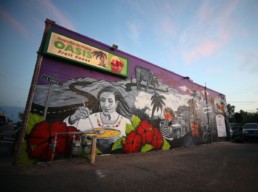Growing and Greening the Food Economy of La Doce Barrio
Growing and Greening the Food Economy of La Doce Barrio
Year Complete: 2018
Grant Amount: $74,862
Local Government: City of Tucson, AZ
Local Foundation: Community Foundation for Southern Arizona
Project Purpose
To support a marginalized community in developing strategies to strengthen their food-based economy, including an ethnographic-based food system assessment that captures local cultural knowledge and foodways.
Key Lessons Learned
Lessons learned about tools and tactics through the project that other sustainability directors could use to advance their work.
- Finding and engaging with the right community lead or partner is an important first step to support leadership that comes from within the community. Organizations that are viewed as representing a community, but are authorized or endorsed by outside agencies (such as neighborhood associations or Chambers of Commerce) may not fall within, and may even be at odds with, the existing power structure within that community. So, developing an understanding of how communities self-organize and “get things done” is essential.
- The leaders in a community may not be obvious; identifying and getting buy-in from at least some of them is critical. In the case of this project, the City-recognized neighborhood association was not viewed to be representative of the community’s interests and relying on them to be the ambassador to the community would have greatly hampered project success.
- Do not assume that a relatively homogenous-seeming community is indeed so. Even though the La Doce community is predominately Hispanic, the project team learned that the community was comprised of two distinct groups: (1) people who had been born in Mexico and moved to Tucson, spoke mostly or only Spanish, and whose children were first generation Americans and (2) families that had resided in Tucson for generations and spoke little to no Spanish. It was important to understand the extent to which each group’s perspective was represented in the data collection, and the successful implementation of recommendations required buy in from both groups.
- Work with “non-planners”—social services, community organizers, anthropologists, folklorists, youth, artists, and cross-sector stakeholders—is essential to looking at bigger issues of inequality in regional planning and city services. Having non-traditional perspectives in the planning process supports the identification of innovative solutions to community needs.
Lessons for developing a collaborative process between a local government sustainability director and local place-based foundation(s).
- Patience and communication is key.
- Start building a relationship with as close to the top of the organization as you can, ideally with the President/CEO.
- Learn not only what kinds of projects in which the foundation is investing their time and resources, but what kinds of issues their leadership is passionate about.
- Don’t be too invested in a specific idea. Take the time to learn the culture of the organization and always make an opportunity for deepening your collaboration.
- Community Foundations are extraordinary resources in a community, however, the time in which a donor is ready to invest may not always align with the readiness of a community or vice versa.
- Maintaining clear expectations and consistent communications helps to realize opportunities when all invested participants are in alignment.
Additional Information and Resources
Over the course of one year, the project engaged a broad cross section of partners representing food security, policy, culture, equity and food justice. Together with residents, partners learned to develop community driven support systems for the unique foodways in Tucson’s south side. See the full report.
A mini documentary was produced here.

